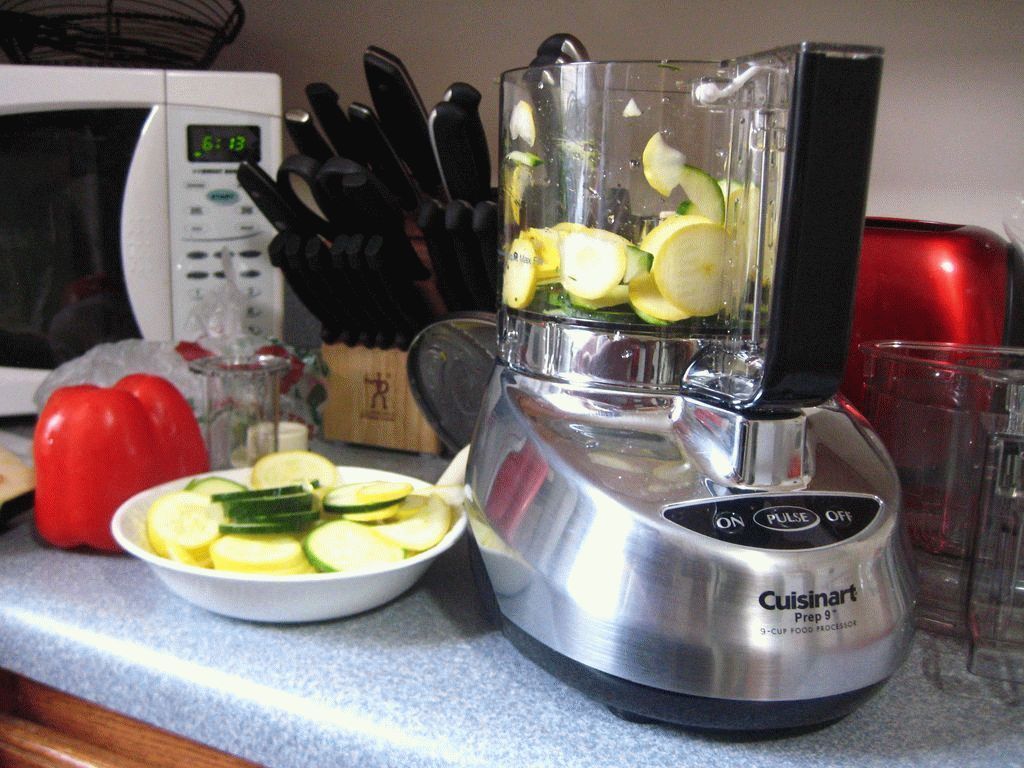Ranking of the best refrigerants for 2025
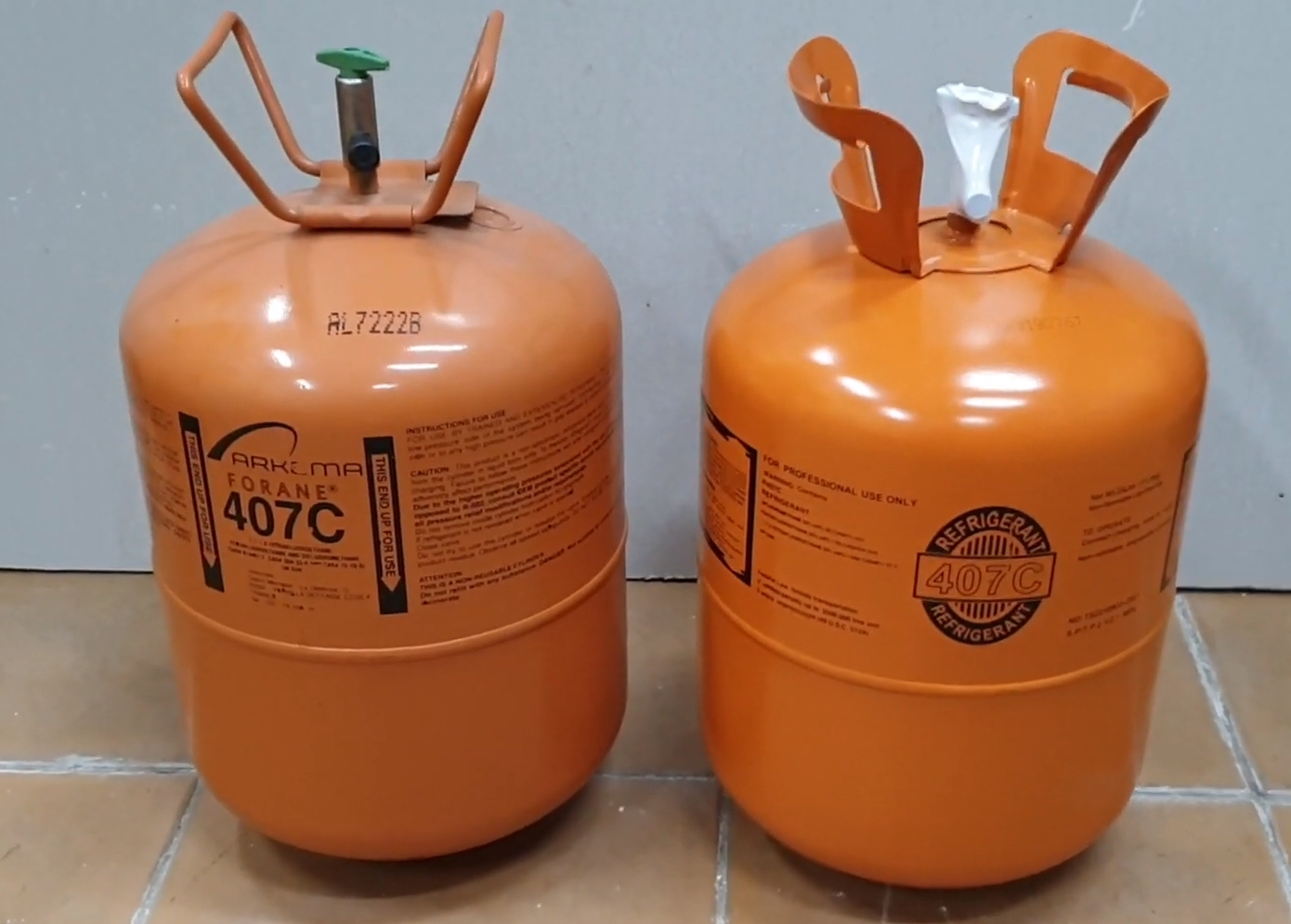
There are many popular types and models of refrigerants, they are usually used for refrigerators, refilling air conditioners, thermal bags. The first cold accumulators used ammonia, sulfur dioxide, propane, ethane and metal chlorides, these types of reagents are still used in various equipment. However, because these substances are not the safest and have negative environmental impact with undesirable characteristics, they have been replaced by less toxic materials specifically designed for household use.
In our review, we will provide recommendations: “what you need to pay attention to so as not to make a mistake when choosing a reagent”, “which company is the best product to buy”, we will determine the popular manufacturers of low-temperature refrigerants, the best-selling models for auto-conditioners, we will orient at average prices.
Content [Hide]
Types of refrigerants
Cooling of commercial equipment, centrifugal piston compressors, air conditioners is provided by special reagents: R-134a, R-22, R-404A, R-507 and R-410A. Many compounds used today are divided into two groups of compounds:
- carbon, fluorine, chlorine, in some cases hydrogen;
- ammonia and HFCs (hydrofluorocarbons).
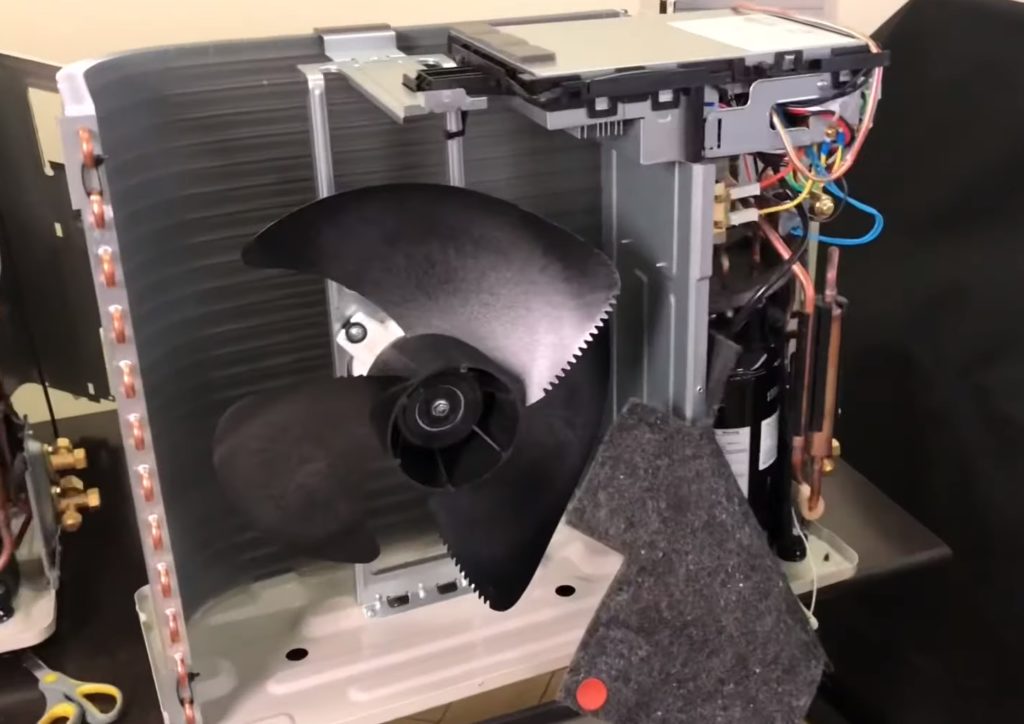
Reagents are indicated by numbers after the letter R, which indicates that we have a refrigerant in front of us. The identification system is standardized by ASHRAE (American Society of Heating, Refrigeration and Air Conditioning Engineers). You need to know the numbers, as well as the names of the products:
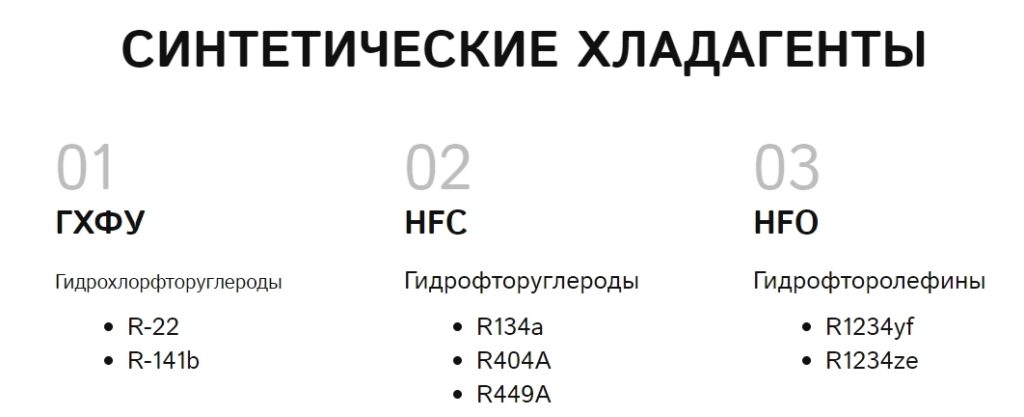
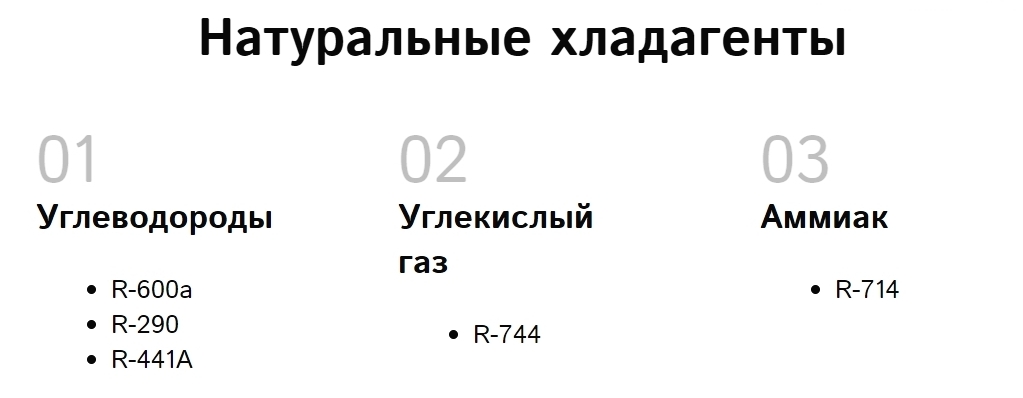
It should be noted that azeotropic blends are transitional refrigerants that have been developed to replace R-22 and R-502.
How to choose a refrigerant
For a formulation to be suitable for your application, it must have certain physical, chemical and thermodynamic properties that make it safe to use.
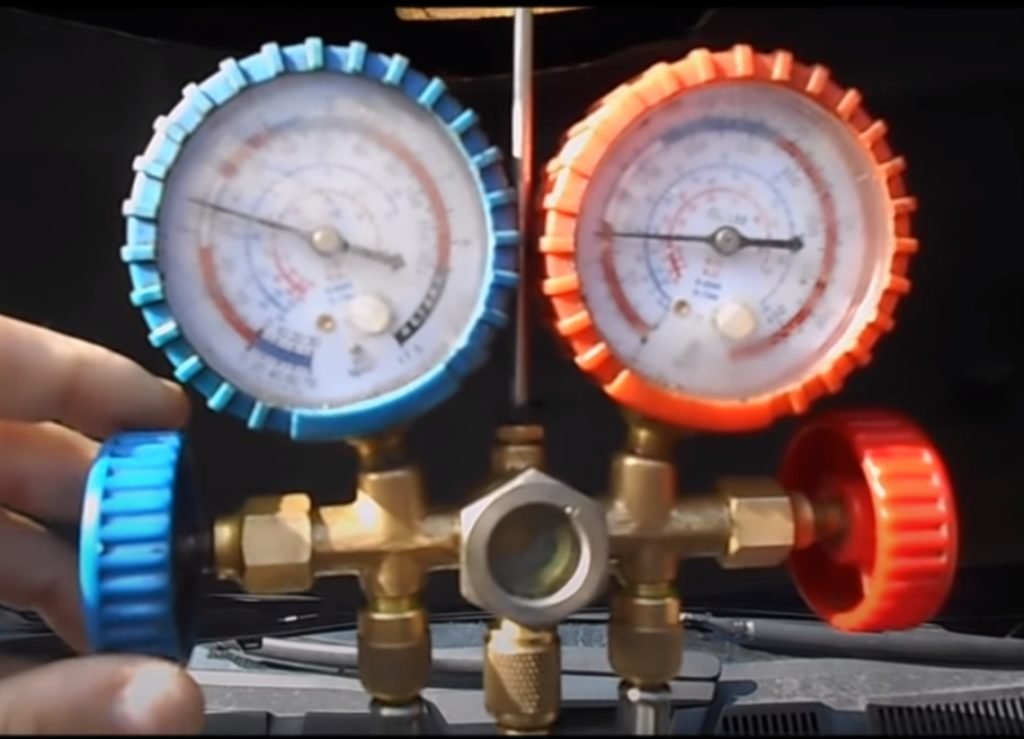
Refrigerants are the vital fluids of a refrigeration system. Any substance that changes from liquid to vapor and vice versa can act as a refrigerant.
There is no best reagent that can be universally adapted to all types of equipment. We denote the important parameters of the liquid so that it can be used as a coolant:
- Low t°C at boiling point, it must be below ambient temperature at atmospheric pressure.
- The boiling point must be in a stable state in order to maintain the ability to absorb heat.
- The higher the latent evaporation rate, the more heat is absorbed per kilogram of refrigerant used.
- Non-flammable, explosion-proof, non-toxic. The chemical stability of the composition contributes to its repeated repetition of the state change.
- The fluid must be non-corrosive to metal, to allow the use of common materials in system construction and to ensure long service life of all components.
- Reagents with high condensing pressure (more than 25-28 kg/cm2) require massive equipment. Vacuum mode (less than 0 kg / cm 2) creates the possibility of air entering the system.
- Easy detection and localization of leaks.
- Harmless to oils, the properties of the coolant should not affect the lubricating effect.
- The freezing point must be well below any t°C at which the evaporator can operate.
- The steam must not condense at temperatures above the critical temperature, no matter how high the pressure. For most refrigerants, this temperature is above 93 °C.
- Moderate specific steam volume to minimize compressor size.
- Low cost to keep equipment price reasonable and provide proper service.
The above characteristics are important for determining the criteria for selecting a suitable formulation. The ideal refrigerant absorbs all vapors from the compressor by condensing them.Unfortunately, all refrigerants, circulating in the system, return some of the heat back, reducing the performance of the equipment.
A typical system has many sensors that report the state of the refrigerant at various points in the system, and many controls allow adjustments to be made when needed. These devices are important to maintain the desired conditions for changing the cooling load.
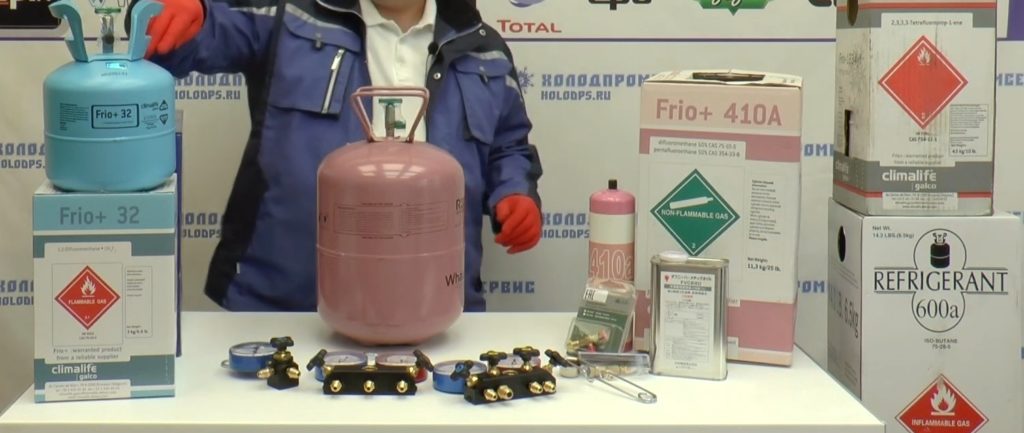
Effective use of a refrigerant involves understanding its relationship between pressure and temperature in the system. It is equally important to understand how heat is absorbed when it changes from liquid to vapor and vice versa. These properties distinguish different compositions from each other. The ideal option should have the following characteristics, consider what they are:
- the system must be able to work with increasing pressure;
- the critical t°C of the liquid must be above the condensing temperature, the freezing t°C below the evaporating t°C, the boiling t°C is low;
- the specific volume must be low in the vapor phase and high in the liquid;
- enthalpy is the great value of the latent heat of vaporization;
- the corresponding density, entropy.
It is easy to understand that none of the known products meets all these qualities. In other words, there is no ideal option, so based on the balance of pros and cons, you should choose the one that matches the greatest number of these characteristics. Important properties affecting performance and efficiency:
- Except for very small systems, it is desirable to have a high "latent heat" value so that the weight of matter per unit of power is kept to a minimum.As a result, you will significantly increase the performance, efficiency of the compressor, which will reduce energy consumption.
- It is better to have a low specific heat capacity of the product in the liquid state, a high value in the vapor state, since the cooling effect per unit weight increases.
- At low coolant compression ratios, low energy consumption, high efficiency will be observed, which is especially important in small systems, since this allows the use of mobile compressors.
By increasing conductivity, heat transfer coefficients can be improved, especially in the case of liquid cooling, thereby reducing equipment size and cost. The ratio of pressure to temperature of the refrigerant must be above atmospheric. This minimizes the possibility of air, moisture entering the system in the event of a leak. The condensing pressure is required to be low, this allows the use of lightweight materials in the construction of the equipment, reducing its size and cost.
Environmental issues
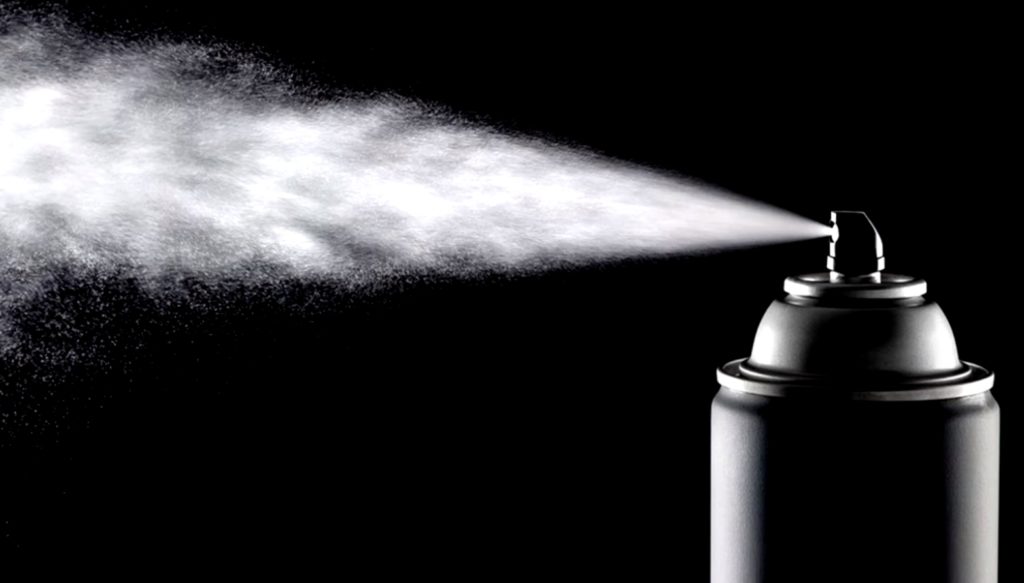
The use of CFC compounds (chlorofluorocarbons) present in aerosols, refrigerants catalyzes the reactions of ozone destruction, under the action of solar radiation. In addition, the presence of these compounds in the atmosphere contributes to the greenhouse effect. Given the seriousness of this problem, various countries have begun to introduce legal restrictions on the production and sale of these substances. Refrigerants are classified according to different properties, they are divided into groups:
Inorganic:
- water;
- ammonia.
Organic:
- hydrocarbons and their derivatives.
Harmful to the ozone layer:
- HCFCs, Hydrochlorofluorocarbons;
- HFC;
- HC: hydrocarbons (alkanes and alkenes);
- Mixtures, azeotropic or non-azeotropic.
Substances have 3 degrees of safety:
- Group 1: non-flammable, non-toxic.
- Group 2: poisonous, corrosive or explosive substances at high concentration (3.5% mixed with air). Includes ethyl chloride ammonia, methyl chloride, sulfur dioxide, "R-717" is still used to some extent to this day.
- Group 3: These refrigerants are highly flammable and explosive. Due to their low cost, they are used by petrochemical plants. This group includes butane, propane, isobutane, ethane, ethylene, propylene and methane.
These compounds must operate at a pressure above atmospheric pressure to avoid the risk of explosion.
Where could I buy
Inexpensive new items can be purchased at a specialized supermarket, managers will provide advice on choosing the right substance, tell you how much it costs, and recommend popular companies that produce excellent products.
Rating of quality refrigerants for 2025
Our list is based on real reviews, it takes into account the opinion of buyers who are familiar with coolers and their descriptions.
Inexpensive
R134a Suva, Dupont
votes 15
Suva134a is marketed by DuPont as a replacement for chlorofluorocarbons (CFCs) and is used in many applications. This product is chlorine free and works in many areas where CFC‑12 is currently used. In some cases, modification of the compressor design is necessary.
Suva 134a's thermodynamic and chemical properties and low toxicity make it a safe and very effective replacement for CFC‑12. The substance is used in industrial refrigerators, car air conditioners, household and commercial appliances. Suva134a ignites at a pressure of only 0.38 kg/cm2 and must be in excess of 60% air.
At low t°C, higher ignition pressure is required. The substance is sold in cylinders of 17.1 kg. Evaporation temperature: -7 C to 7 C, composition: 100% HFC-134a.
Technical indicators:
| Options | Characteristics |
|---|---|
| Weight of gas in a cylinder, kg | 13.6 |
| Oil type compatibility | Synthetic |
| Overall dimensions in packing, mm | 250x250x420 |
| Volume, cubic meters | 0.026 |
| Manufacturer | DuPont |
| Gross weight, kg | 17.1 |
- versatility of application.
- not detected.
Freon 290
votes 2
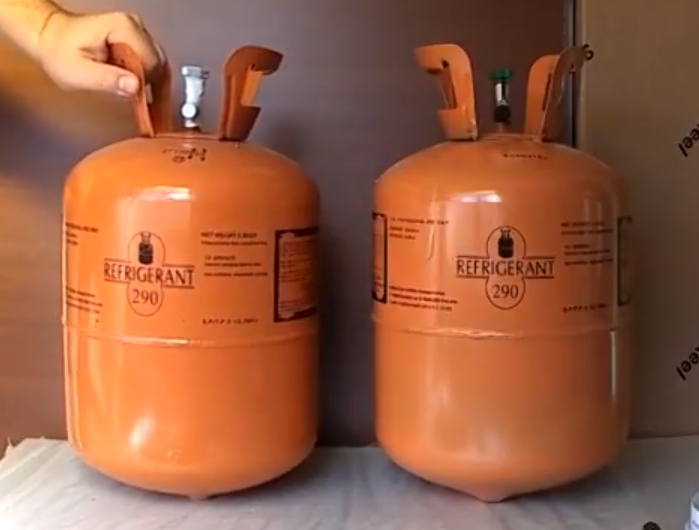
"R290" (propane) is a colorless, non-toxic gas belonging to the group of hydrofluorocarbons (HFCs). The substance does not violate the ozone layer, does not affect global warming (GWP=3). The product is soluble in mineral oil. It is important to note that refrigerators that use refrigerant must be installed in a separate, specially equipped room if the mass of the substance in the system exceeds 2.5 kg.
Compressors using propane will be larger than when filled with "R22", the performance is similar. Due to R290's low environmental impact and excellent thermodynamic performance, its use is increasing.
Technical indicators:
| Options | Characteristics |
|---|---|
| Molecular mass | 44.1 |
| Liquid phase density under normal conditions kg/m3 | 510 |
| Gas phase density: | |
| under normal conditions | 2.019 kg/m3 |
| at 15°С | 1,900 kg/m3 |
| Specific heat of vaporization | 484.5 kJ/kg |
| Lowest calorific value: | |
| in liquid state | 65.6 MJ/l |
| in gaseous state | 45.9 MJ/kg |
| in gaseous state | 85.6 MJ/m3 |
| Octane number | 120 |
| Flammable limits in mixture with air under normal conditions | 2,1–9,5 % |
| Auto ignition temperature | 466 |
| Theoretically, the amount of air required for combustion of 1 m3 of gas | 23.80 m3 |
| Volumetric expansion coefficient of the liquid fraction | 0.003% per 1°С |
| Boiling point (at 1 bar) | -42.1 °С |
| Item weight | 800 g |
- high thermodynamic parameters of the gas;
- environmental friendliness.
- not detected.
R600, bottle 0.83 kg with valve
votes 1
"R600" (isobutane) is natural gas, so it does not harm the ozone layer, does not contribute to the greenhouse effect. This characteristic distinguishes it from "R12", "R134a". The mass of the coolant in the refrigeration apparatus when using "R600" is reduced by 30%, in gaseous form, isobutane spreads along the ground.
The substance works well with mineral oils, thanks to which the coefficient of performance increases, energy consumption is reduced compared to "R12". The product is used in home refrigerators, air conditioners.
It is necessary to store "R600" at t°С not higher than 20°С, while it is important to minimize the ingress of sunlight. Isobutane must be kept away from the fire, because. it is explosive, its share in the atmosphere should not exceed 8.5%.
Technical indicators:
| Options | Characteristics |
|---|---|
| Packaging, kg (gross) | 0.83 |
| Packaging, kg (net) | 0.42 |
| Producing country | China |
- does not affect the environment;
- soluble in mineral oil;
- energy saving;
- not detected.
Average in price
R408a
votes 0
"R408a" is an azeotropic composition of hydrofluorocarbon nature, it includes:
- freon "R22" / 45%;
- freon "R143a" / 46%;
- "R125" / 5%.
The product is safe for the environment, does not burn, does not emit toxic substances, which distinguishes it favorably from other models.
"R408A" synthesized as a replacement for "R502", has become popular among commercial enterprises, used inside household refrigerators. As a result of the experiments, it turned out that the use of "R408A" saves 8% of the consumed electricity, increases the productivity of the equipment. The product is miscible with polyester, synthetic, alkylbenzene oils.
The substance can be transported by various means of transport, store the mixture only in dry rooms where protection from sunlight is observed, it is necessary to keep containers away from open flames and electrical heating equipment.
"R408a" is an azeotropic mixture, as a result of which it does not change its chemical composition as a result of multiple leaks, refueling. Non-hazard and stability of performance characteristics are the main advantages of the substance in question. All in all, purchasing the R408a is a bargain that will greatly increase the efficiency of the equipment without the need to install a new compressor.
Technical indicators:
| Options | Characteristics |
|---|---|
| t°С boiling point | -44.4 °C. |
| Maximum (critical) temperature of boiling | 23.5°C. |
| t°C glide | 0.6 °C. |
| critical pressure | 4.34MPa. |
| Ozone depleting factor potential | ODP 0.026. |
| Global Warming Potential (GWP) | 3 050. |
| Compatible oils | Mobil Gargoyle Arctic Oil 155 and 300, Mobil EAL Arctic 100, 66, 46, 32, SHC 200 and SHC 400, LUNARIA SK, Bitzer B5.2 and B100. |
| Tara | 10.9 kg. |
- consumption of "R408a" is less by 15-25%;
- when replacing freon, there is no need to completely remove the oil;
- equipment parameters are improved;
- simple service, "R408a" can be replaced after each leak;
- safety, ease of use;
- compatible with "R502";
- no chlorine;
- versatility, used at home, in production;
- saving up to 8% of electricity;
- documents confirming compliance with international regulations.
- not detected.
Mcool 22
votes 1
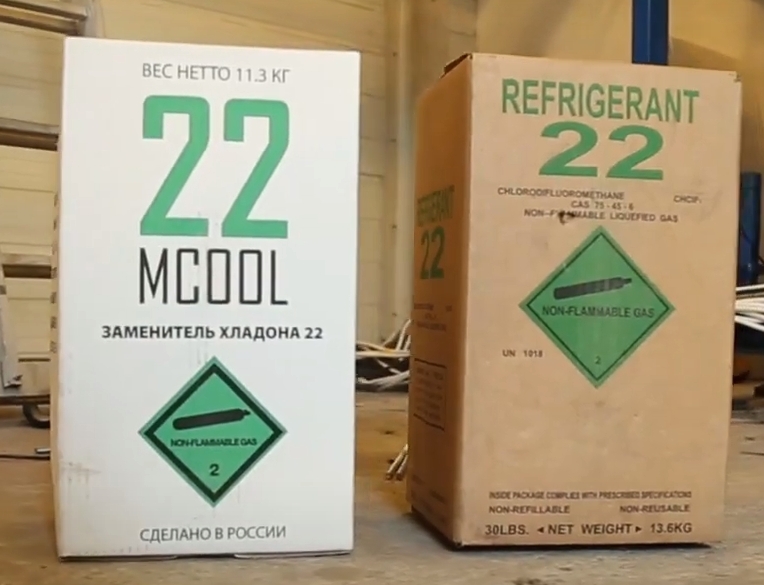
"R-22" is used in home air conditioners, commercial and industrial refrigerators, reciprocating, centrifugal and screw compressors. Cooler 22 (CHCIF) has a boiling point at normal atmospheric pressure of 40.8°C, while the t°C in the evaporator is 87°C. The main advantage of the product is the very low heat of the working volume of the compressor.
"R-22" works well in large hermetic motor-compressor units. At low t°C and high pressure, it is necessary to cool the unit head with water. The substance is successfully mixed with the oil in the condensation compartment, then separated from it in the booster. Appropriate design of the evaporator coil and suction tubes guarantees trouble-free oil return to the system. "Mcool 22" is a fluorocarbon, it is safe for the environment and people. You can buy it in reusable or disposable containers.
Technical indicators:
| Options | Characteristics |
|---|---|
| Brand | R22 and substitutes |
| Manufacturer | Russia |
| Boiling point at 1.013 bar, °C | -42.1 |
| Critical temperature, °C | 83.77 |
| Critical pressure, MPa | 4.85. |
| ASHRAE Hazard Class 34 | A1 |
| Liquid density at +25°C, kg/m3 | 1096 |
- efficiency;
- tactlessness;
- versatility of application.
- not detected.
Freon R32
votes 0
"R32" is a one-component substance that has a lower density than "R410A", while it has excellent performance, allowing saving up to 30% of refrigeration fluid.The main advantage of "R32" is its low density and enviable thermal conductivity. Given this fact, we can confidently talk about a decrease in pressure losses in the system by 5-10%, the cooling efficiency increases by 5-7%.
"R32" belongs to the gas class of refrigerants with a reduced ignition rate, which makes its safety as harmless as possible. The characteristics of freon "R32" and "R410A" are similar in their thermodynamic properties, therefore, the equipment used for refueling air conditioners, copper pipes, oil are similar. It is necessary to transport "R32" according to the regulations "transportation of dangerous goods". It is recommended to store in a dry, ventilated warehouse, not exposed to direct sunlight.
Technical indicators:
| Options | Characteristics |
|---|---|
| Boiling temperature | - 51,7 ℃ |
| Critical temperature | 78,4 ℃ |
| critical pressure | 5.843 MPa |
| Hazard Class | 4 |
| Global warming potential | 580 GWP |
| The weight | 10 kg |
| Country of Origin | China |
- the possibility of refueling without draining;
- does not require a major upgrade of equipment, switching to "R32";
- leakage does not cause difficulties when refueling;
- increased productivity, excellent vapor pressure compared to other liquids;
- multiple refueling does not affect the properties of the cooler;
- its characteristics are close to "R410A";
- environmental friendliness, safety, ease of use;
- low operating costs;
- not detected.
Expensive
Freon R23
votes 0
"R23" (fluoroform) is a modified HFC capable of reacting with alcohols, organochlorine compounds, ketones, ethers. The substance is environmentally friendly, does not destroy the ozone layer. "R23" is able to replace freons "R-503" and "R-13".It is important to clarify that the substance does not corrode the elements of the equipment where it is used. The term of use of freon is not limited.
Freon 23 is a colorless and odorless gas, it belongs to flame retardants, therefore it is often used for localizing fires, filling extinguishing systems with it (use is possible after the removal of personnel from the premises):
- in refrigerators, freezers;
- air conditioners;
- in the implementation of organic synthesis;
- as a reagent for dry etching of large electronic circuits.
- "R 23" is able to generate up to -100 ° C, which is necessary for medical institutions.
Freon 23 passes into a liquid state under a pressure of 4.83 MPa, evaporation is observed at -82.1 ° C, the substance belongs to the 4th hazard class and does not pose a threat to the environment and people.
The product is transported in 40 l metal cylinders or other cylindrical containers. The tank must withstand a working pressure of 9.8 MPa. Delivery is carried out by any mode of transport, designed for these cargo transportation.
"R 23" is stored in covered warehouses or outdoor areas, the main condition is the absence of direct sunlight, the air temperature should not be higher than +50 °C.
Technical indicators:
| Options | Characteristics |
|---|---|
| Volume fraction of the main substance, %, min | 99.98 |
| Volume fraction of difluorochloromethane, carbon dioxide and other organofluorine impurities in total, %, not more than | 0,2 |
| Mass fraction of water, %, no more | 0.005 |
| Acidity | Withstands the test |
| Relative molecular weight | 70.014 |
| Melting point, °С | -155.15 |
| Boiling point, °С | -82.2 |
| Critical temperature, °С | 25.85 |
| Critical pressure, MPa | 4.82 |
| Critical density, kg/m3 | 525 |
- used in fire fighting;
- environmental friendliness;
- does not cause corrosion.
- not detected.
Freon R141
votes 0
"R141B" coolant-solvent (fluorodichloroethane C2FCl2H3), used to flush heat pumps, air conditioners in a car, replaces "R11" and "R113", while the substance does not corrode the sealant, does not burn, colorless in appearance. Applying the liquid for 60 minutes, you can not worry about the metal elements of the equipment, it has anti-corrosion properties.
Vapors from "R141B" ignite if its concentration in the air is from 5.6% to 17%. The substance does not react with most chemical elements, while it can be mixed with dry nitrogen, compressed air, oxygen.
Technical indicators:
| Options | Characteristics |
|---|---|
| Name | Freon 141b, R141b, 1-fluoro-1,1-dichloroethane |
| Chemical formula | C2FCI2-H3, Light boiling clear colorless liquid |
| Molecular weight, g/mol | 116,950 |
| Boiling point at pressure 101325 Pa (1.013 bar), °C | 31,9 |
| Critical temperature, °С | 201,5 |
| Critical pressure, MPa | 4,25 |
| Critical density, kg/m3 | 464,0 |
| Melting point, °С | -103,5 |
| Ozone Depletion Potential (ODP) | 0,11 |
| Global Warming Potential (GWP) | 630 |
| Type of | HCFC |
| ODP | 0,11 |
| GWP | 630 |
| MAC rz, mg/m3 | 1000 |
| HGWP | < 0,15 |
| Hazard Class | 4 |
- in the liquid state does not burn;
- mixed with dry nitrogen.
- not detected.
R404A Suva freon DuPont
votes 3
"R404A" has a rich composition: 52% "R125"; 44% "R143a"; 4% "R134a". This substance is a hydrofluorocarbon (HFC), successfully replaces "R22" and "R502", for the transition it is necessary to change the filter, mineral oil to polyester, make a slight modification to the equipment design.
"R404A" has a minimal impact on the ozone layer (ODP=0), a global warming possibility (GWP) of 3750.In ten years, according to the decision of the European Parliament, the use of R404a, other fluorinated gases that increase the greenhouse effect, must decrease by 79%.
"R404a" consists of elements with a similar boiling point, is an azeotrope. The substance compares favorably with "R22" and "R502" due to the low discharge t°C, which provides excellent efficiency.
Freon "R404A" is used by refrigeration systems in trade, industry (low, medium temperature), transport (refrigerators).
Technical indicators:
| Options | Characteristics |
|---|---|
| Weight of gas in a cylinder, kg | 10.9 |
| Oil type compatibility | Synthetic |
| Overall dimensions in packing, mm | 250x250x420 |
| Volume, cubic meters | 0.026 |
| Manufacturer | DuPont |
| Substitutes | R507 |
| Gross weight, kg | 14.4 |
- the substance is leak stable;
- similarity with freon "R507";
- refueled in the form of a liquid;
- "R404A" is a quasi-zeotrope, has a temperature change of less than half a degree.
- not detected.
Freon R410A
votes 2
DuPont sells this product under the name Suva 9100. "R410A" replaces "HCFC-22" in domestic air conditioning systems, heating pump equipment. R410A is suitable for new or existing equipment and is similar in performance to HCFC-22.
"R410A" is a replacement for the more powerful "R22" freon. It is sold in disposable 11.3 kg cans. Its composition is 60% HCFC-22, 23% HFC-152a and 27% HCFC-124.
Technical indicators:
| Options | Characteristics |
|---|---|
| Boiling temperature | - 52,2 ℃ |
| Critical temperature | 72,2 ℃ |
| critical pressure | 4.95 MPa |
| Hazard Class | 4 |
| Global warming potential | 1890 GWP |
| The weight | 11.3 kg |
| Country of Origin | China |
- The best ratio of price and quality;
- not detected.
We hope our review will help you make the right choice of quality refrigerant!
new entries
Categories
Useful
Popular Articles
-

Top ranking of the best and cheapest scooters up to 50cc in 2025
Views: 131654 -

Rating of the best soundproofing materials for an apartment in 2025
Views: 127695 -

Rating of cheap analogues of expensive medicines for flu and colds for 2025
Views: 124522 -

The best men's sneakers in 2025
Views: 124039 -

The Best Complex Vitamins in 2025
Views: 121943 -

Top ranking of the best smartwatches 2025 - price-quality ratio
Views: 114982 -

The best paint for gray hair - top rating 2025
Views: 113399 -

Ranking of the best wood paints for interior work in 2025
Views: 110321 -

Rating of the best spinning reels in 2025
Views: 105332 -

Ranking of the best sex dolls for men for 2025
Views: 104370 -

Ranking of the best action cameras from China in 2025
Views: 102220 -

The most effective calcium preparations for adults and children in 2025
Views: 102014


